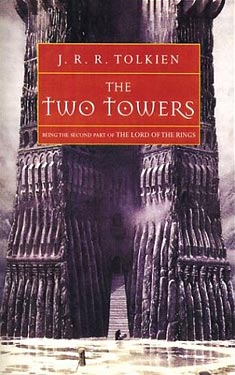JRR Tolkien
Completed 2/22/2015, Reviewed 2/27/2015
5 stars
Whew! I was relieved that
in reading the Two
Towers
Note: Because this is
the second book of a trilogy, and because there is so much going on, there are
some spoilers in the following summary.
Even though I made it through this book in fewer days than
“Fellowship”, I actually slowed down my reading. I spent more time reveling in the prose,
drinking in the descriptions and dialogues, and treasuring the experience. The story picks up as the fellowship is
breaking up. While Frodo and Sam have
gone off on their own, Merry and Pippin have been captured by a large army of
Orcs. They escape when the Riders of
Rohan attack the Orcs, hiding in Fangorn
Forest
Aragorn, Gimli, and Legolas go in search of Merry and
Pippin, but Gandalf redirects them to Rohan.
There, they join forces with King Theoden as they prepare for battle
against Saruman’s forces at Helm’s Deep.
In the meantime, Frodo and Sam continue towards Mordor to destroy the
Ring. They encounter Gollum, using him
as their guide through the evil terrain.
It’s difficult to say much more than what I already said in
my review of “Fellowship”. The prose is
still stupendous. One point that comes
to mind is the characterization of Legolas and Gimli. With the breaking of the fellowship, they get
a lot more to say and do than before, which fleshes out their characters much
better.
A second point is the lack of female characters. I think this is more obvious reading it 30
years later and having the film in my head.
Eowyn, Theoden’s niece, is only seen briefly. Having read the whole trilogy before and
knowing her role in the third book, it is sad that she has little character
development here. Aowyn, if my memory is
correct, isn’t referenced in this book at all.
I’ll be able to speak more of this once I get to the Appendices in the
“Return of the King”. When I read the
book in the ‘70s and ‘80s, I probably didn’t notice this nearly as much. Now, my response to the lack of female
characters is the same as when I read golden age SF: it’s a sad reflection of the time and culture
of the writers.
My last comment is about Grima Wormtongue. I often find it difficult to swallow
characters whose names reflect some aspect of their personalities. I mean, really, did a person with a name like
Grima Wormtongue ever have a chance at a good, happy life? His name fates him to his miserable
existence. Unfortunately, it is way too
common in fantasy for bad characters to have names that signify their
wickedness. I think it would be an
interesting exercise to come up with names that more reflect the attractiveness
of the temptation of evil.
Again, rating this book separately from the whole trilogy
just seems wrong. But I will give it
five stars out of five. I loved reading
it, getting deeper into the looming apocalypse, loving the Ents once again,
feeling the despair and heroism, being surprised by the complexity and depth,
and knowing that there’s still more to come.

No comments:
Post a Comment